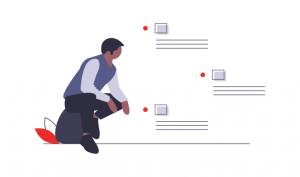Johari Window Model – Tool to Build Self Awareness, Trust and Communication
Behind the rather exotic name of The Johari Window may be an interesting choice of selecting words from the names of its creators – Joseph Luft and Harry Ingham, but the tool is very simple and effective.
It addresses the core objective of building a trusting relationship at work. We all know how effective a team with such traits are and how it can translate to effective business results.
All teams rely on a combination of self-awareness, trust, and communication to run like a finely tuned engine.
In this article, we’ll cover how you and your team members can use the Johari Window to develop self-awareness, trust, and communication with groups, and therefore, grow as people and as colleagues.
Johari Window Definition
The Johari window is a technique that helps people better understand their relationship with themselves and others.
The technique was created by psychologists Joseph Luft and Harrington Ingham in 1955 and is used primarily in self-help groups and corporate settings as a heuristic exercise.
The Johari Window Model

The model is based on two basic premises – trust within teams can be acquired by revealing information about you to others and learning yourselves from their feedbacks.
Each individual in the Johari Window model is represented by four quadrants or 2 by 2 matrix. Each quadrant contains adjectives which in turn are personal information, feelings, and motivation.
The placing of adjectives in each quadrant is based on whether that information is known or unknown to oneself or others (peers) in four quadrants.
How to conduct Johari Window exercise

In the exercise, the participant picks a number of adjectives from a list, choosing ones they feel describe their own personality. The participants’ peers then get the same list, and each picks an equal number of adjectives that describe the subject.
These adjectives are then inserted into a two-by-two grid of four cells as represented above.
The final output is the four quadrants with adjectives describing the participant.
1. Open/self-area or arena

The adjectives that both the subject and peers select goes into this cell or quadrant of the grid. These are traits that both the participant and peers recognize and reveal.
Here, the information about the person his attitudes, behavior, emotions, feelings, skills, and views that the participant is self-aware and also known by peers.
This is mainly the area where all the communications occur and the larger the arena becomes the more effective and dynamic the relationship will be. The overall objective should be to maximize the number of adjectives that go into this quadrant or area.
One way to do it through feedback solicitation. It is a process of understanding and listening to feedback from peers and taking steps towards self-improvement.
In this way, the open area can be increased horizontally decreasing the blind spot. The size of the arena can also be increased downwards and thus reducing the hidden and unknown areas by revealing one’s feelings to another person.
2. Blind Spot

Adjectives not selected by the participant, but only by their peers go in this quadrant. These represent what others perceive and reveal but the participant does not.
Information about yourselves that others know in a group but you will be unaware of it. Others may interpret yourselves differently than you expect. The blind spot is reduced for efficient communication by seeking feedback from others.
3. Hidden area or facade

Adjectives selected by the participant, but not by any of their peers, go in this quadrant. These are things the peers are either unaware of, or that are untrue. But it true for the participant or he/she believes so.
However, this may also be any personal information that you feel not to reveal. This includes feelings, anxieties, past experiences, fears, secrets, etc. we keep some of our feelings and information as private as it affects the relationships.
However, an attempt must be made to reduce the hidden area and increasing the size of the open area through trust-based communications.
4. Unknown area

Adjectives that neither participant nor peers select, go in this quadrant. They represent the subject’s behaviors or motives that no one participating recognizes—either because they do not apply or because of collective ignorance of these traits.
The individual will be unaware until he discovers his/her hidden qualities and capabilities or through observation of others. Open communication and self-reflection is also an effective way to decrease the unknown area resulting in effective communication.
Choice of Adjectives in Johari Window
One of the most important aspects of the Johari Window exercise is the choice of adjectives. The best way to do it is to use a standard list that applies to most teams.
However, specific teams or projects may utilize a competency-based approach and include the behavioral indicators as adjectives in the Johari Window exercise.
You can download The standard list of adjectives for Johari Window exercise below
 |
| There are many ways to use the Johari model in learning and development. It very much depends on what you want to achieve through your training or development initiative.
A selection of adjectives that best addresses your project or organizational requirement will help you achieve open communication and a drive to self-improvment in those specific ares. Johari is a very elegant and powerful model, and as with other powerful ideas, simply helping people to understand is the most effective way to optimise the value to people. When people really understand it through self-discovery, it empowers them to use the thinking in their own way, and to incorporate the underlying principles into their future thinking and behaviour. You can also introduce Belbin Team Roles to reinforce role of each team member in a group. |
Conclusion
In the words of philosopher Charles Handy, he calls it a concept of the Johari House with four rooms. Room one is the part of ourselves that we and others see. Room two contains aspects that others see but we are unaware of.
Room three is the private space we know but hide from others. Room four is the unconscious part of us that neither ourselves nor others see.
The exercise and model allow us to look at ourselves and others which can do a long way to improve all aspects of our relationship and communication with others, who matter.

